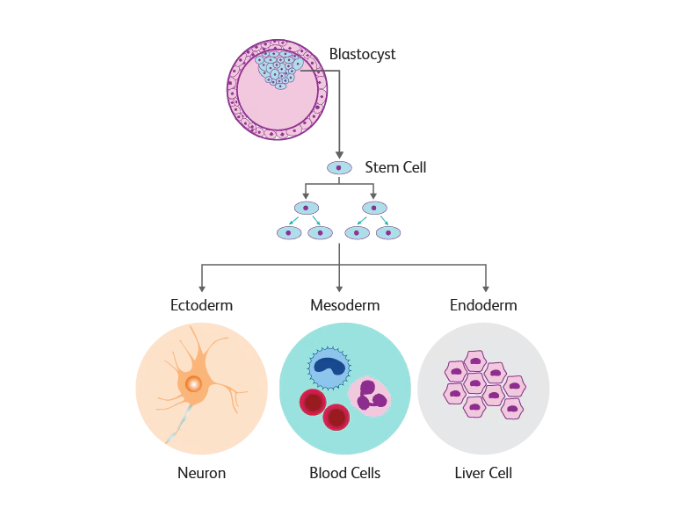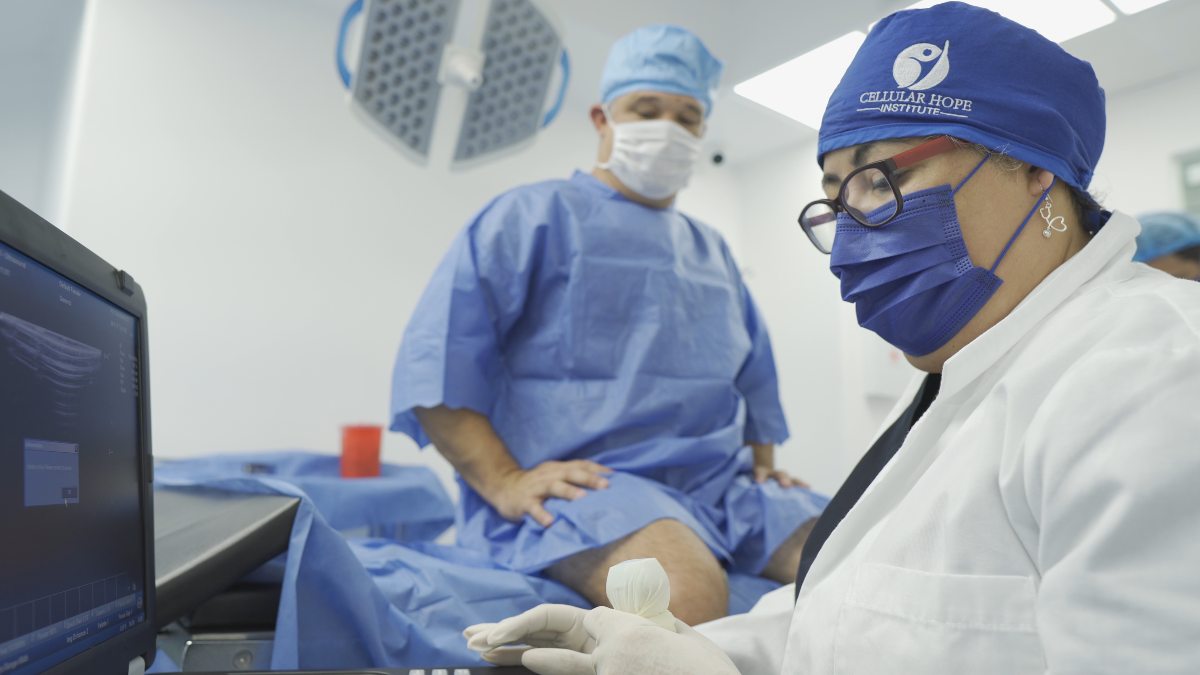Are stem cells right for you if you are suffering from arthritic knees? Learn more about getting a stem cell therapy for arthritic knees.
Whether you are suffering from osteoarthritis, rheumatoid arthritis, or post-traumatic arthritis, one thing is certain – it can be a painful condition that not only takes the joy out of your everyday activities, but also decreases your mobility and impacts your quality of life.
If you’ve already tried pain relievers, topical treatments, or corticosteroid Injections, but the pain relief is just temporary, don’t worry. There is hope – a stem cell therapy for arthritic knees can be a great long term solution for your pain.
But what exactly is a stem cell therapy for arthritic knees, and how does it work? Continue reading this article to find out everything you need to know about stem cell treatments – and most importantly, where you can get them.
What Is Stem Cell Therapy?
A stem cell therapy is a type of medical treatment that uses stem cells – unique cells in the body that have the ability to develop into different cell types – to treat or prevent various conditions and diseases, such as osteoarthritis, autoimmune conditions, and others.

Stem cells are unspecialized, which means that they don’t have a predetermined function.
This makes them a powerful tool for medical treatments because experienced physicians such as Cellular Hope Institute can convert them into a variety of differentiated cells, such as muscle, bone, or nerve cells. They also have the ability to divide and multiply.
As opposed to short-term treatments or surgery, a stem cell therapy for arthritic knees:
- Offers long-term pain relief thanks to its ability to repair and regrow damaged tissue rather than just targeting symptoms;
- Is minimally invasive, meaning you won’t have to worry about lengthy recovery times or the risks associated with major surgery;
- Promotes natural healing by using your body’s own cells to restore joint health, activating its repair mechanisms;
| Treatment | Symptom Relief | Cartilage Repair | Inflammation Control | Invasiveness | Longevity |
| Medications (NSAIDs, etc.) | Yes | No | Partial | Non-invasive | Short-term |
| Corticosteroid Injections | Yes | No | Temporary | Minimally | Short-term |
| Physical Therapy | Yes | No | No | Non-invasive | Variable |
| Joint Replacement Surgery | Yes | Complete (synthetic) | Yes | Highly invasive | Long-term (artificial joint) |
| Stem Cell Therapy | Yes | Yes | Yes | Minimally | Long-term |
How Does Stem Cell Therapy For Arthritic Knees Work?
Stem cell therapy helps with arthritic knees by repairing damaged cartilage, reducing inflammation, and promoting natural tissue regeneration.
The most common types of cells used for this treatment are mesenchymal stem cells (MSCs), which can differentiate into cartilage cells, restoring joint cushioning and function.
Let’s take a quick look at how the process works:
1. Preparation of Stem Cells
The first step of performing stem cell therapy for arthritic knees is the preparation of stem cells. There are two types of stem cells when it comes to source – autologous, which are derived from your own body from bone marrow or adipose tissue, and allogeneic, which are sourced from a donor.
As a reputable clinic with highly experienced physicians, Cellular Hope Institute will carefully prepare the stem cells in sterile conditions to ensure maximum safety and effectiveness.
We typically work with allogeneic cells, which are carefully selected from young, healthy, and strictly screened donors. This guarantees consistent quality, high potency, and powerful regenerative capacity to ensure the successful outcome of your stem cell treatment.
Because these stem cells are processed in advance and don’t have to be harvested from scratch from your own body, you can save a lot of time when coming for the procedure.
2. Injection of Stem Cells
When it comes to stem cell therapy for arthritic knees, the second step is the injection of the cells into your joints. At Cellular Hope Institute, we typically perform this process under imaging guidance, such as ultrasound or fluoroscopy to ensure their precise placement.
We will inject the concentrated stem cells directly into your knee joint, where they will begin to work by targeting damaged cartilage, reducing inflammation, and releasing growth factors.
3. Migration To The Site of Damage
When cartilage is damaged as a result of arthritis or injury, it releases specific biochemical signals which act as distress signals, such as chemokines and pro-inflammatory cytokines.
Once the stem cells are injected, they detect these signals through receptors on the surface, and migrate to the injury site within the knee joint through a process called homing. The stronger the signal at the injury site, the more stem cells are attracted to that area.
The stem cells then adhere to the injured cartilage or surrounding tissue, and initiate the process of repair and regeneration in stem cell therapy for arthritic knees.
4. Release Of Growth Factors
During this process of repair and regeneration, stem cells release bioactive molecules, including growth factors, cytokines and exosomes. They encourage the proliferation of local cells, and the formation of new blood vessels to nourish the damaged tissue.
In other words, they deliver healing signals to begin the repair processes, all while recruiting additional healing cells to the area – hooray!
5. Differentiation Into Cartilage Cells
As we mentioned earlier, stem cells have the ability to differentiate into other types of cells – in the case of stem cell therapy for arthritic knees, they differentiate into chondrocytes (cartilage-forming cells), which is key for their regenerative potential.
As mesenchymal stem cells mature into chondrocytes, they begin expressing specific markers and proteins unique to chondrocytes, such as collagen type II and aggrecan – which are essential for cartilage structure and function.
The newly formed chondrocytes secrete components of the extracellular matrix (ECM), which forms the structural foundation of cartilage. ECM restores the cushioning and smooth surface of the joint, improving its ability to absorb shock and reduce friction.
What Are The Outcomes of Stem Cell Therapy For Arthritic Knees?
Now that you are aware of the process that involves stem cell therapy for arthritic knees, you might be wondering – what are the final outcomes from this procedure? What can I expect after I’ve undergone this treatment?
On top of the benefits we mentioned earlier, you can expect:
- Reduced Inflammation – Since stem cells suppress the inflammatory processes of osteoarthritis and other similar conditions, they help slow the progression of your condition, and prevent further cartilage degradation.
- Regenerated Cartilage – Over weeks to months after the stem cell therapy for arthritic knees, your body will begin to regenerate cartilage in the affected joints, which will improve joint cushioning and function.
- Better Joint Stability – As joint tissue is being remodeled by stem cells and growth factors, you will notice improved joint stability and mobility, allowing you to go back to your day-to-day activities without pain.
- Decreased Pain – As opposed to treatments that only provide temporary pain relief, stem cell therapy for arthritic knees will decrease your chronic pain long-term, especially as inflammation slowly begins to subside.
- Slower Disease Progression – Another great benefit of stem cell therapy for arthritic knees is that it slows down disease progression. By reducing inflammation and encouraging tissue repair, the therapy works to preserve the existing cartilage and joint health.
FAQ
Who is a candidate for stem cell therapy for arthritis?
Candidates for stem cell therapy for arthritic knees are typically individuals with mild to moderate arthritis who have not found sufficient relief from conservative treatments like physical therapy, medications, or injections.
Ideal candidates are generally in good overall health, have a body mass index (BMI) within a healthy range, and do not have conditions such as active infections or cancer that could interfere with the therapy’s effectiveness.
What is the recovery time after the procedure?
Recovery time after stem cell therapy for arthritis varies but is generally minimal compared to surgical interventions. Most patients can resume light activities within 1-2 days, though some soreness at the injection site may last for a few days.
Strenuous activities or high-impact exercise should be avoided for 4-6 weeks to allow optimal healing and regeneration. Full benefits may take 3-6 months to develop.
What are the success rates of stem cell therapy for arthritic knees?
The success rates of stem cell therapy for arthritic knees vary due to differences in study designs and patient populations. Some studies report significant pain reduction and improved joint function, while others find outcomes comparable to traditional treatments like corticosteroid injections.
Overall, more high-quality, long-term research is needed to establish definitive success rates.
How many sessions of stem cell therapy are typically needed for knee arthritis?
The number of stem cell therapy sessions needed for knee arthritis depends on the severity of the condition and the patient’s response. Typically, most patients undergo a single session, as it often provides noticeable benefits.
However, some individuals may require a follow-up session after 6-12 months if symptoms persist or for maintenance. Your physician will recommend a personalized treatment plan.
What are the qualifications of a good stem cell therapy provider?
A good stem cell therapy provider should have formal medical training, such as an MD or DO, and specialized expertise in regenerative medicine or orthopedics. They should be board-certified and experienced in performing stem cell procedures.
The provider should prioritize patient safety, and offer clear, evidence-based guidance. Positive patient reviews and transparent practices are also key indicators.

